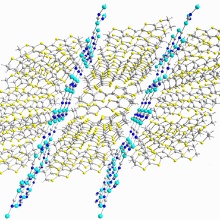Physicists distinguish metals that conduct electricity well from insulators that do not conduct electricity. Metals that do not conduct electricity are described as Mott insulators[1]. Researchers from the University of Stuttgart headed by Professor Martin Dressel from the Institute of Physics (1) have now succeeded together with scientists from universities in the USA, Russia and Japan in researching the so-called Mott transition in terms of how non-conductive metals become conductive metals. The international team sees this success as an approach for the construction of electrical component parts with completely novel properties. They also consider this to be a possibly decisive component in order to solve the riddle of the high temperature superconductivity.
Mott insulators indeed contain sufficient electrons to conduct electricity well, yet these impede each other to such an extent that that can hardly move. In the case of low temperatures the electrons get stuck, like river floes.
The British Nobel laureate in Physics Nevill Mott had already assumed this in the 1930s; however, it was not until 50 years later that it was possible to calculate the properties of such metals. Accordingly, they contain an unimaginable number of electrons that mutually influence each other: in one cube of one centimeter edge length there are 1020 electrons, a huge number with twenty zeroes, comparable with the entire data storage capacity worldwide. With the help of sophisticated computer models the scientists were able to ultimately calculate that the electrical repulsion of electrons can become so great to the extent that nothing moves any more. No power flows, the electrons get stuck. If it were therefore possible – according to the approach by the physicists – to reduce the repelling force, the material would become metallic at a certain point. This is described as the Mott transition from an insulator to a metal.
Checking the details of such a pure Mott transition in an experiment was not possible up to now. The reason was the magnetic properties of the investigated materials. The brilliant idea by the Stuttgart physicists was now to research materials that are not magnetic, so-called quantum spin liquids. They succeeded for the first time in investigating the Mott transition from an insulator to a metal in an experiment. Metallic fluctuations were proven, i.e. an uncertainty brought about by the quantum features of the electrons that were obfuscated with other metals of the magnetic order. The fact that this no man’s land at the boundary between insulator and metal has now been made accessible could open up new applications in material research and quantum electronics.
Quantum spin liquids were discovered in the 2000s and suppress each magnetic order up to the absolute zero temperature due to their layout in a triangle – in technical jargon described as “geometric frustration”. The magnetic spins are faced with a tricky problem and do not know how they should react. The Stuttgart researchers have now discovered that these spins can contribute towards the optical features although the electrons no longer move.
[[1] Throughout his life the British Nobel laureate in Physics Sir Nevill Mott (1905-1996) has been dealing with the properties of electrons in solid objects; in 1980 he was awarded the honorary doctorate from the University of Stuttgart.
The expert articles were published in Nature Materials 2018 in August 2018 (https://doi.org/10.1038/s41563-018-0140-3) and Physical Review Letters 121, 056402 (2018) (https://doi.org/10.1103/PhysRevLett.121.056402)
Expert Contact:
Prof. Dr. Martin Dressel
1. Physikalisches Institut an der Universität Stuttgart,
email
phone.: +0049711 685 64946


